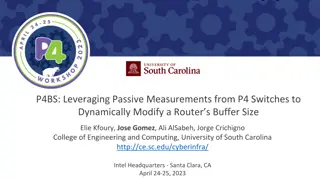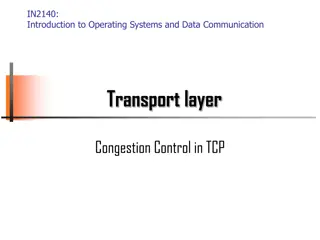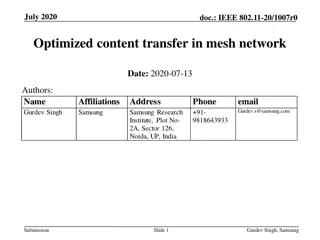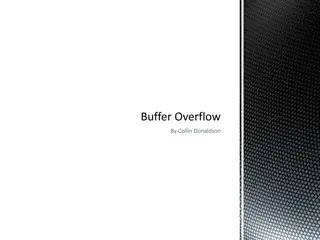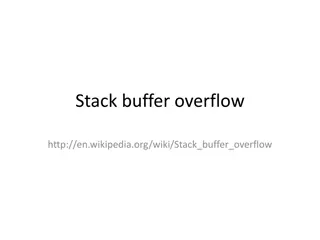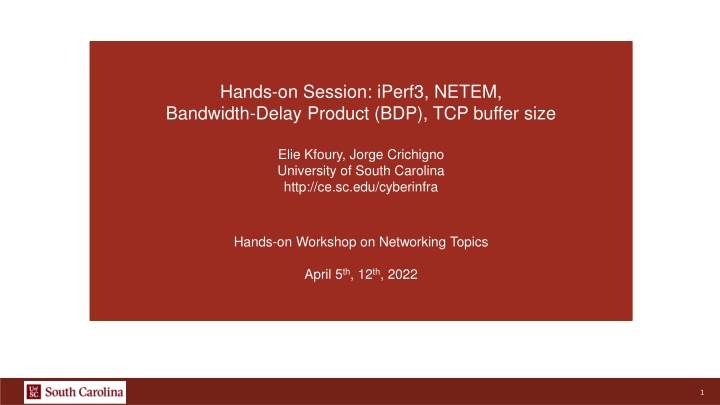
Networking Workshop: Hands-on Session with iPerf3, NETEM, Bandwidth-Delay Product
Explore hands-on sessions covering iPerf3, NETEM, Bandwidth-Delay Product (BDP), TCP buffer size, and more in this networking workshop. Dive deep into experiments and labs focusing on network performance and optimization techniques.
Download Presentation

Please find below an Image/Link to download the presentation.
The content on the website is provided AS IS for your information and personal use only. It may not be sold, licensed, or shared on other websites without obtaining consent from the author. If you encounter any issues during the download, it is possible that the publisher has removed the file from their server.
You are allowed to download the files provided on this website for personal or commercial use, subject to the condition that they are used lawfully. All files are the property of their respective owners.
The content on the website is provided AS IS for your information and personal use only. It may not be sold, licensed, or shared on other websites without obtaining consent from the author.
E N D
Presentation Transcript
Hands-on Session: iPerf3, NETEM, Bandwidth-Delay Product (BDP), TCP buffer size Elie Kfoury, Jorge Crichigno University of South Carolina http://ce.sc.edu/cyberinfra Hands-on Workshop on Networking Topics April 5th, 12th, 2022 1
Content Introduction to Mininet Introduction to iPerf3 Introduction to TCP buffers, BDP, and TCP window BDP and buffer size experiments Modifying buffer size and throughput test 2 Bandwidth-delay Product and TCP Buffer Size
NTP Lab Series Lab experiments Lab 1: Introduction to Mininet Lab 11: Router s Buffer Size Lab 2: Introduction to iPerf Lab 12: TCP Rate Control with Pacing Lab 3: WANs with latency, Jitter Lab 13: Impact of Maximum Segment Size on Throughput Lab 4: WANs with Packet Loss, Duplication, Corruption Lab 14: Router s Bufferbloat Lab 5: Setting WAN Bandwidth with Token Bucket Filter (TBF) Lab 15: Hardware Offloading on TCP Performance Lab 6: Traditional TCP Congestion Control (HTCP, Cubic, Reno) Lab 16: Random Early Detection Lab 7: Rate-based TCP Congestion Control (BBR) Lab 17: Stochastic Fair Queueing Lab 8: Bandwidth-delay Product and TCP Buffer Size Lab 18: Controlled Delay (CoDel) Active Queue Management Lab 9: Enhancing TCP Throughput with Parallel Streams Lab 19: Proportional Integral Controller-Enhanced (PIE) Lab 10: Measuring TCP Fairness Lab 20: Classifying TCP traffic using Hierarchical Token Bucket (HTB) 3 NTP Lab Series
Introduction to Mininet 4 Introduction to Mininet
Mininet Mininet provides network emulation opposed to simulation, allowing all network software at any layer to be simply run as is Mininet s logical nodes can be connected into networks Nodes are sometimes called containers, or more accurately, network namespaces Containers consume sufficiently few resources that networks of over a thousand nodes have been created, running on a single laptop 5 Introduction to Mininet
MiniEdit MiniEdit is a simple GUI network editor for Mininet 6 Introduction to Mininet
MiniEdit To build Mininet s minimal topology, two hosts and one switch must be deployed 7 Introduction to Mininet
Introduction to iPerf3 8 Introduction to iPerf3
iPerf3 iPerf3 is a real-time network throughput measurement tool It is an open source, cross-platform client-server application that can be used to measure the throughput between the two end devices Measuring throughput is particularly useful when experiencing network bandwidth issues such as delay, packet loss, etc. 9 Introduction to iPerf3
iPerf3 iPerf3 can operate on TCP, UDP, and SCTP, unidirectional or bidirectional way In iPerf3, the user can set client and server configurations via options and parameters iPerf3 outputs a timestamped report of the amount of data transferred and the throughput measured 10 Introduction to iPerf3
Lab 8: Bandwidth-delay Product and TCP Buffer Size 11 Bandwidth-delay Product and TCP Buffer Size
Section 1: Introduction to TCP buffers, BDP, and TCP window 12 Bandwidth-delay Product and TCP Buffer Size
TCP Buffers The TCP send and receive buffers may impact the performance of Wide Area Networks (WAN) data transfers At the sender side, TCP receives data from the application layer and places it in the TCP send buffer 13 Bandwidth-delay Product and TCP Buffer Size
TCP Buffers Typically, TCP fragments the data in the buffer into maximum segment size (MSS) units At any given time, the TCP receiver indicates the TCP sender how many bytes the latter can send, based on how much free buffer space is available at the receiver To Application (in-order delivery) From Application TCP receive buffer TCP send buffer 201-300 101-200 1-100 801-900 701-800 ... ... 301-400 Seq. number (first byte in segment) 201-300 101-200 1-100 ... From Network To Network 501-600 401-500 ... Ack-101 Ack-201 Ack number (next expected byte) 14 Bandwidth-delay Product and TCP Buffer Size
TCP Buffers RTT and TCP buffer size have throughput implications For example, assume that the TCP buffer size is 1 Mbyte and RTT is 50ms 1 Mbyte = 1,048,576 bytes = 1,048,576 8 bits = 8,388,608 bits With a bandwidth (Bw) of 10 Gbps, this number of bits is approximately transmitted in: After 0.84 milliseconds, the TCP send buffer will be empty TCP must wait for the corresponding acknowledgements (arriving at t = 50ms) This means that the sender only uses 0.84/50 or 1.68% of the available bandwidth 15 Bandwidth-delay Product and TCP Buffer Size
Bandwidth-delay product The solution lies in allowing the sender to continuously transmit segments until the corresponding acknowledgments arrive back The number of bits that can be transmitted in an RTT period is the bandwidth-delay product (BDP) For the previous example The first factor (10 109) is the bandwidth; the second factor (50 10-3) is the RTT 16 Bandwidth-delay Product and TCP Buffer Size
Practical Observations on Setting TCP Buffer Size Linux assumes that half of the send/receive TCP buffers are used for internal structures Thus, only half of the buffer size is used to store segments Considering the previous example, the TCP buffer size must be: 17 Bandwidth-delay Product and TCP Buffer Size
Section 2: BDP and buffer size experiments 18 Bandwidth-delay Product and TCP Buffer Size
Emulating a Wide Area Network The first figure shows the topology and the devices interfaces The second and third figures show the command that sets a latency of 20ms and bandwidth to 10 Gbps h1 h2 s1 s2 10 Gbps h1-eth0 s1-eth1 s2-eth2 s2-eth1 h2-eth0 s1-eth2 10.0.0.1 10.0.0.2 19 Bandwidth-delay Product and TCP Buffer Size
Verification The user can now verify the previous configuration by using the iperf3 tool to measure throughput Server (h2) Client (h1) 20 Bandwidth-delay Product and TCP Buffer Size
Section 3: Modifying buffer size and throughput test 21 Bandwidth-delay Product and TCP Buffer Size
BDP and buffer size To achieve the full throughput, the user has to modify the send and receive windows in host h1 and host h2 22 Bandwidth-delay Product and TCP Buffer Size
Verification The user can now verify the previous configuration by using the iperf3 tool to measure throughput Server (h2) Client (h1) 23 Bandwidth-delay Product and TCP Buffer Size



